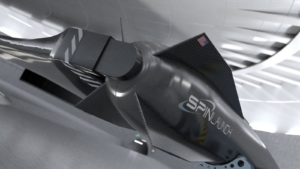SpinLaunch joins cadre of small launch companies DoD wants to try out

WASHINGTON — Startup SpinLaunch is the latest small launch provider that has partnered with the Defense Innovation Unit to help the military figure out how to use and acquire these companies’ services.
SpinLaunch announced June 19 that it received an “other transaction authority,” or OTA cost-sharing contract from DIU, the Pentagon’s technology outreach office in Silicon Valley. RocketLab and Vox Space previously announced they entered OTA agreements with DIU. A fourth provider was selected but its name has not been disclosed. A DIU spokesperson said the organization leaves it up to awardees to announce contracts.
The Air Force Space and Missile Systems Center in 2017 asked DIU for help figuring out how to work with emerging small launch providers after Congress inserted $15 million into the Pentagon’s budget for the “Rapid Agile Launch Initiative.” DIU sought proposals from vendors for “responsive launch” options and selected four from a total of 24 submissions.
DIU defines responsive launch as “low-cost, precise, and on-demand deployment of small payloads into space.”
Small launch provider RocketLab on May 5 lifted three experimental Air Force satellites to orbit in the first of five missions planned for 2019 under the rapid launch initiative. Vox Space is on deck to launch later this year. The company will use Virgin Orbit’s LauncherOne rocket that is air launched from a Boeing 747 mothership.
“DIU looks at a variety of different technologies — like Rocket Labs and Vox which are more mature as well as potentially disruptive capabilities like SpinLaunch,” the DIU spokesperson told SpaceNews.
Diane Murphy, a spokeswoman for SpinLaunch, said the company came up with an entirely different approach to fly small payloads to orbit. SpinLaunch encapsulates payloads in a launch vehicle and uses ground based energy to hurl the vehicle out of its electric kinetic launcher. There are no ground based rockets or rocket fuel involved. The payload’s velocity is over four times the speed of sound and reaches space in a matter of seconds. The spinner can be powered by renewable energy like solar or wind.
Murphy said the company is building a test site at Spaceport America in New Mexico but has not yet selected a launch site. “It won’t be in Florida,” she said, because of air traffic restrictions. SpinLaunch wants to be able to launch five times a day at $250,000 per shot.
DIU will work with the four companies to map out how DoD would buy launch services. The Air Force Space and Missile Systems Center has a process for buying national security launch services from companies like United Launch Alliance and SpaceX but doesn’t have a comparable procurement strategy for small launch services.
The Air Force Experimental Launch and Test Division (LEX), based at Kirtland Air Force Base, New Mexico, buys small launches for the Defense Department’s Space Test Program in onesies and twosies but not as a service. DIU will look at how these companies might be put on contract where the Air Force could buy more than one launch at a time. “There are so many new providers. It’s a way for us to touch different parts of the market and try them all out,” the DIU spokesperson said.
Request for information
Separately from the DIU program, the Air Force is surveying the small launch industry to better understand what different companies bring to the table. On May 30 the Air Force Space and Missile Systems Center Launch Enterprise Systems Directorate issued a request from vendors for a “statement of capabilities” to meet rapid space launch requirements. Proposals are due July 15.
“The U.S. Air Force is investigating the possible procurement of a capability to rapidly launch and deploy space payloads critical to national security in an ultra-responsive manner,” the solicitation said. “The objective is 24 hours from ‘call up’ notification to on-orbit capability.”
Air Force Space and Missile Systems Center Commander Lt. Gen. John Thompson said SMC wants to partner “with many small launch providers to get 400 kg or 450 kg payloads to low Earth orbit as reliably and cheaply as possible.” The industry is undergoing some turbulence right now as companies are still figuring out their business models, Thompson said last week at a conference hosted by MITRE. “It’s rough and tumble right now. … SMC is engaged with small launch providers to test, certify and make sure providers can do what we need to do, do it reliably and do it rapidly.”
A more recent DIU solicitation that just closed on June 16 focused on “tactical launch.” It asked for “commercial solutions to demonstrate the capacity for rapid, low cost, flexible launch using mobile or transportable solutions that allow for operations independent of fixed-site launch infrastructure. … Solutions should be capable of long range, suborbital flight to the limit of placing small payloads into mission-designed low Earth orbits.”
There is excitement in the Air Force about cheaper and faster launch, said Robert Unverzagt, principal director of civil and commercial launch projects at the Aerospace Corp., a federally funded research and development organization that supports Air Force space launch operations.
But he cautioned that the Air Force will have to adjust its expectations as it looks to buy more services from commercial providers. SMC is used to working with big rocket manufacturers that design their vehicles to meet government requirements and ensure the risks of losing expensive satellites are minimized. That type of “mission assurance” would not apply when working with small launch providers that would be flying lower cost payloads and where more risk could be tolerated, Unverzagt said at the MITRE conference.
“It’s a balance between risk tolerance versus responsiveness,” he said. “It’s an equation that the government has to come to terms with,” Unverzagt added. “Government mission assurance has to be appropriately sized to allow this responsiveness.”
from SpaceNews.com http://bit.ly/2KsnPjF
Comments
Post a Comment